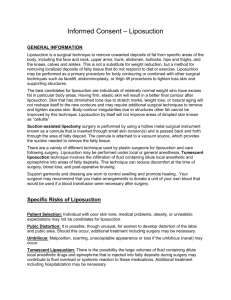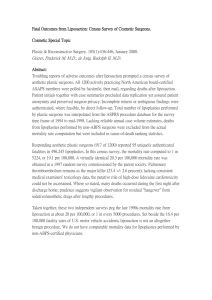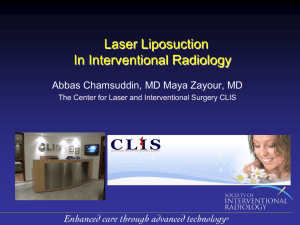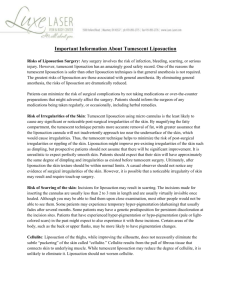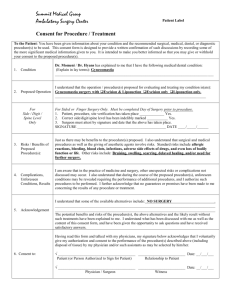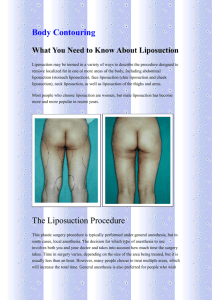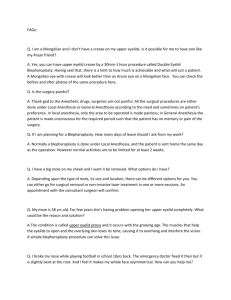VIGILON/SECOND SKIN Wound Dressing
advertisement
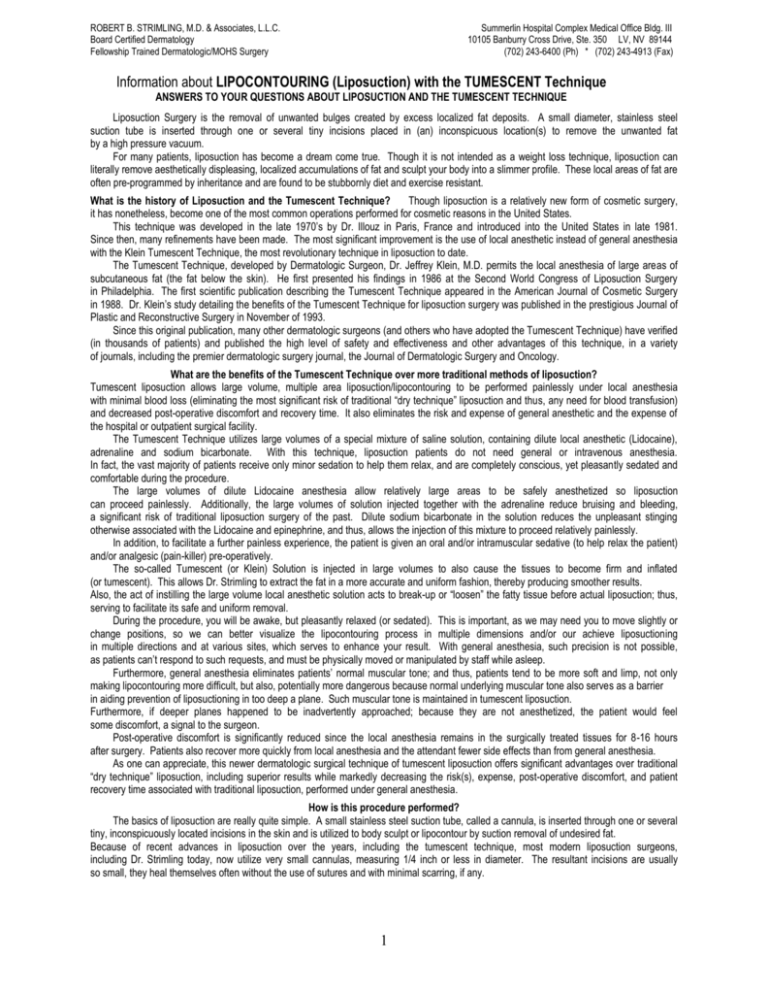
ROBERT B. STRIMLING, M.D. & Associates, L.L.C. Board Certified Dermatology Fellowship Trained Dermatologic/MOHS Surgery Summerlin Hospital Complex Medical Office Bldg. III 10105 Banburry Cross Drive, Ste. 350 LV, NV 89144 (702) 243-6400 (Ph) * (702) 243-4913 (Fax) Information about LIPOCONTOURING (Liposuction) with the TUMESCENT Technique ANSWERS TO YOUR QUESTIONS ABOUT LIPOSUCTION AND THE TUMESCENT TECHNIQUE Liposuction Surgery is the removal of unwanted bulges created by excess localized fat deposits. A small diameter, stainless steel suction tube is inserted through one or several tiny incisions placed in (an) inconspicuous location(s) to remove the unwanted fat by a high pressure vacuum. For many patients, liposuction has become a dream come true. Though it is not intended as a weight loss technique, liposuction can literally remove aesthetically displeasing, localized accumulations of fat and sculpt your body into a slimmer profile. These local areas of fat are often pre-programmed by inheritance and are found to be stubbornly diet and exercise resistant. What is the history of Liposuction and the Tumescent Technique? Though liposuction is a relatively new form of cosmetic surgery, it has nonetheless, become one of the most common operations performed for cosmetic reasons in the United States. This technique was developed in the late 1970’s by Dr. Illouz in Paris, France and introduced into the United States in late 1981. Since then, many refinements have been made. The most significant improvement is the use of local anesthetic instead of general anesthesia with the Klein Tumescent Technique, the most revolutionary technique in liposuction to date. The Tumescent Technique, developed by Dermatologic Surgeon, Dr. Jeffrey Klein, M.D. permits the local anesthesia of large areas of subcutaneous fat (the fat below the skin). He first presented his findings in 1986 at the Second World Congress of Liposuction Surgery in Philadelphia. The first scientific publication describing the Tumescent Technique appeared in the American Journal of Cosmetic Surgery in 1988. Dr. Klein’s study detailing the benefits of the Tumescent Technique for liposuction surgery was published in the prestigious Journal of Plastic and Reconstructive Surgery in November of 1993. Since this original publication, many other dermatologic surgeons (and others who have adopted the Tumescent Technique) have verified (in thousands of patients) and published the high level of safety and effectiveness and other advantages of this technique, in a variety of journals, including the premier dermatologic surgery journal, the Journal of Dermatologic Surgery and Oncology. What are the benefits of the Tumescent Technique over more traditional methods of liposuction? Tumescent liposuction allows large volume, multiple area liposuction/lipocontouring to be performed painlessly under local anesthesia with minimal blood loss (eliminating the most significant risk of traditional “dry technique” liposuction and thus, any need for blood transfusion) and decreased post-operative discomfort and recovery time. It also eliminates the risk and expense of general anesthetic and the expense of the hospital or outpatient surgical facility. The Tumescent Technique utilizes large volumes of a special mixture of saline solution, containing dilute local anesthetic (Lidocaine), adrenaline and sodium bicarbonate. With this technique, liposuction patients do not need general or intravenous anesthesia. In fact, the vast majority of patients receive only minor sedation to help them relax, and are completely conscious, yet pleasantly sedated and comfortable during the procedure. The large volumes of dilute Lidocaine anesthesia allow relatively large areas to be safely anesthetized so liposuction can proceed painlessly. Additionally, the large volumes of solution injected together with the adrenaline reduce bruising and bleeding, a significant risk of traditional liposuction surgery of the past. Dilute sodium bicarbonate in the solution reduces the unpleasant stinging otherwise associated with the Lidocaine and epinephrine, and thus, allows the injection of this mixture to proceed relatively painlessly. In addition, to facilitate a further painless experience, the patient is given an oral and/or intramuscular sedative (to help relax the patient) and/or analgesic (pain-killer) pre-operatively. The so-called Tumescent (or Klein) Solution is injected in large volumes to also cause the tissues to become firm and inflated (or tumescent). This allows Dr. Strimling to extract the fat in a more accurate and uniform fashion, thereby producing smoother results. Also, the act of instilling the large volume local anesthetic solution acts to break-up or “loosen” the fatty tissue before actual liposuction; thus, serving to facilitate its safe and uniform removal. During the procedure, you will be awake, but pleasantly relaxed (or sedated). This is important, as we may need you to move slightly or change positions, so we can better visualize the lipocontouring process in multiple dimensions and/or our achieve liposuctioning in multiple directions and at various sites, which serves to enhance your result. With general anesthesia, such precision is not possible, as patients can’t respond to such requests, and must be physically moved or manipulated by staff while asleep. Furthermore, general anesthesia eliminates patients’ normal muscular tone; and thus, patients tend to be more soft and limp, not only making lipocontouring more difficult, but also, potentially more dangerous because normal underlying muscular tone also serves as a barrier in aiding prevention of liposuctioning in too deep a plane. Such muscular tone is maintained in tumescent liposuction. Furthermore, if deeper planes happened to be inadvertently approached; because they are not anesthetized, the patient would feel some discomfort, a signal to the surgeon. Post-operative discomfort is significantly reduced since the local anesthesia remains in the surgically treated tissues for 8-16 hours after surgery. Patients also recover more quickly from local anesthesia and the attendant fewer side effects than from general anesthesia. As one can appreciate, this newer dermatologic surgical technique of tumescent liposuction offers significant advantages over traditional “dry technique” liposuction, including superior results while markedly decreasing the risk(s), expense, post-operative discomfort, and patient recovery time associated with traditional liposuction, performed under general anesthesia. How is this procedure performed? The basics of liposuction are really quite simple. A small stainless steel suction tube, called a cannula, is inserted through one or several tiny, inconspicuously located incisions in the skin and is utilized to body sculpt or lipocontour by suction removal of undesired fat. Because of recent advances in liposuction over the years, including the tumescent technique, most modern liposuction surgeons, including Dr. Strimling today, now utilize very small cannulas, measuring 1/4 inch or less in diameter. The resultant incisions are usually so small, they heal themselves often without the use of sutures and with minimal scarring, if any. 1 What areas are treated? Fat deposits beneath the chin, on the flanks, hips, abdomen, inner and outer thighs, legs and knees are areas where body contouring with liposuction produces impressive results. The most frequently treated areas in women are the abdomen, hips, thighs, and knees, while in men, the flanks (“love handles”), abdomen, and enlarged male breasts (gynecomastia) are most often treated. Also, treatable by liposuction is the condition that causes excess underarm perspiration. Sweat glands in the underarms can be removed by liposuction with no adverse affect on the body’s ability to cool itself. Who is a good candidate for Liposuction Surgery? Those individuals best suited for liposuction contouring are active, healthy persons of average or near average weight, (those overweight can also benefit), have good skin tone and also have realistic expectations. Usually, they have done just about everything possible to lose the unwanted localized fat accumulation(s). Age by itself is not a significant factor. The patient should be in good general health without significant heart or lung problems. Liposuction is a good choice for those who’ve done just about everything possible to lose the unwanted fat accumulations and who seek improvement of their body’s silhouette. Liposuction is not for the very obese patient and is not a substitute for weight loss. There is a limit as to how much fat can be removed safely at one time. Is this a dangerous procedure? Liposuction Surgery has been shown to be a very safe procedure with very few complications. A 1988 review article of nearly 10,000 cases of Liposuction Surgery published in the Journal of Dermatologic Surgery and Oncology reported no serious complications and a very low percentage of minor problems (i.e. temporary swelling, irregularity, numbness, etc.) Where is Liposuction Surgery performed? All cases are performed in our specialized office surgical suite(s) under local tumescent anesthesia with oral and/or intramuscular sedation and analgesia. What is the recovery period? The recovery time varies with how many areas are treated and the type of activity the patient intends to resume. Most patients are performing routine duties or return to work after 2-3 days, but in some cases, 5-6 days of “recovery time” may be necessary. We encourage walking as soon as possible after the surgery, particularly the next day; and most patients feel well enough to go for a walk by this time. In fact, patients report feeling better if they keep moving around as opposed to sitting or lying down in one position for too long. Light exercise may be resumed one week after surgery, or occasionally sooner, although we strongly suggest avoiding vigorous exercise for two weeks. Activities that put excessive stress on treated areas may cause bruising or some discomfort. Will there be bandages or dressings? There usually are usually small dressings covering access sites, that may be removed after 1-2 days or sooner and replaced, if needed. However, special compression garments are worn under clothing for 1 week. These garments are made especially for this procedure. If any foam dressings are used, these should stay as well for one week. (You will be given any pertinent care instructions.) Will the fat regrow? Once puberty is reached no new fat cells develop. The existing fat cells either swell or shrink in size depending on weight gain or loss. When fat cells are removed from a treated area they do not return. Liposuction Surgery is indeed, the only true spot reducer. Long term body weight, however, is minimally influenced. What will happen to the excess skin? Your skin is a dynamic organ which has elasticity and in most cases is able to shrink and reaccommodate to the new body contour. Those who are less ideal candidates for Liposuction Surgery because of decreased skin elasticity can have any remaining excess skin removed, if they so desire at a later date. Although, this is usually not needed. Can the Procedure be repeated? Yes. There is a maximum limit to the amount of fat that can be extracted during one operation. In some instances you may want to repeat or have more removed at another time. We recommend waiting at least 3 months between procedures. What kind of result can I expect? Although the results of liposuction can be spectacular, it is not realistic to expect perfection. Liposuction is the skillful recontouring of the body by removing inches in unwanted areas, rather that pounds. Patients are often advised that while liposuction can enhance one’s appearance in clothes, it cannot be guaranteed to improve the appearance of a person who is nude or wearing a skimpy bathing suit. Skin and muscle tone are also important in a person’s overall appearance - aesthetic aspects that liposuction alone cannot influence. The appearance of “cellulite”, or the doughy, puckery appearance most commonly seen in females is occasionally improved. When will I notice the results? Usually, between 10-30 days. However, improvement continues for up to 1 year. Will I lose weight? Weight loss may be minimal because fat weighs very little. The difference will be seen primarily in the way your clothes fit you. You will probably lose inches and look slimmer. What Side Effects should I be aware of? As with any surgical procedure, liposuction is associated with possible side effects such as bruising, swelling, temporary numbness, and discomfort in the surgically treated area(s). Although irregularities of the skin are possible following liposuction, this side effect is greatly diminished by the Tumescent Technique. The swelling gradually improves over several weeks to several months after surgery, and correlates with noticeable improvement. Optimal results are usually apparent by about 6 months. Bruising varies from person to person, although any noticeable amount is usually gone within 2-3 weeks. Because the Tumescent Technique minimizes post-surgical soreness, any discomfort is usually well-controlled with simple Tylenol or Tylenol with codeine, (but not both at the same time). As judged by current world-wide experience, liposuction using the Tumescent Technique is amazingly safe. Serious complications such as excessive bleeding requiring transfusion, blood clots, systemic infections or allergic reactions are extremely rare. Should you have any additional questions or concerns about liposuction surgery, please do not hesitate to call our office. ROBERT B. STRIMLING, M.D. & ASSOCIATES, LLC * 10105 Banburry Cross Drive, Ste. 350 * (702) 243-6400 (Ph) 2 ROBERT B. STRIMLING, M.D. & Associates, L.L.C. Board Certified Dermatology Fellowship Trained Dermatologic/MOHS Surgery Summerlin Hospital Complex Medical Office Bldg. III 10105 Banburry Cross Drive, Ste. 350 LV, NV 89144 (702) 243-6400 (Ph) * (702) 243-4913 (Fax) WHAT CAN I EXPECT THE DAY OF SURGERY AND HOW CAN I BE PREPARED Upon receiving a scheduled surgical appointment, you will be given separate, detailed materials outlining all preoperative instructions that will help you prepare for surgery. The following, however, will give you a better idea of the actual experience of liposuction surgery and what you can expect. We ask that patients plan to arrive at our office about 30 minutes early. Also, please make arrangements for a responsible adult to drive you home after surgery and for someone to stay with you through the first night after surgery. After you check in and have signed the surgical consent form, we then take pre-operative photographs, as needed and mark the area(s) of your body that are to be treated with liposuction. You will be given an oral sedative (i.e. Valium) and an injection of a pain-killer, as needed to relax and prepare you for the procedure. After one last trip to the bathroom, you will be escorted to the surgical suite. Then you may get comfortable on the surgical table in the position best suited for the area to be treated. At this time, a nurse will “paint” the surgical areas of your body with an antiseptic, to help sterilize the area. We may start an IV in your arm to give you fluids directly. In some instances, a blood pressure cuff is placed on your opposite arm. In addition, a pulse oximeter may be placed on a finger to measure the amount of oxygen in your blood. Next, we anesthetize the sites where the small incisions will be made. Usually, an hour of pre-operative set-up time is required. Although there is some variation from patient to patient, the actual injection of the tumescent anesthetic solution into the fatty tissue is surprisingly easy. Many patients report feeling mild pressure from the (tumescent) inflation of the tissues as opposed to any discomfort from the injections themselves. Then we allow some time for the anesthetic to diffuse into the tissues and fully anesthetize the area/s. Once the area is completely “numb”, the actual liposuction proceeds with little to no discomfort, while you are awake, but sedated. If any tender areas are encountered, more anesthetic solution is administered. Our objective is to make this a comfortable experience for you. Depending on the area(s) to be treated, you may be asked to shift to different positions, making surgical access easier and allowing more precise lipocontouring. After completing surgery, the small incisions are washed and covered with Polysporin or Bacitracin antibiotic ointment and sterile gauze or foam dressings are applied, as needed. Because the incisions are so small, they usually heal without the need for stitches. If any stitches were placed (usually 1 or 2 per incision), these will be removed in 7-10 days, unless they are dissolvable and will disappear on their own over an equal amount of time. Finally, any monitors, blood pressure cuff and IV will be removed. A small pressure dressing/bandage will be placed over the IV site, which can be removed the following day. Then you will be helped into your elastic compression garment, which also helps control swelling and you’re ready to get dressed and go home. Because of residual local anesthetic in the tissue, it may be up to 12 hours or more before any significant soreness, if any begins. We recommend that someone stay with you and keep you company for the first night after surgery. Before you leave, we will review your written post-operative instructions. It is very important that you follow these instructions implicitly to assure the best possible results. We will also make a follow-up appointment for you in approximately 1 week after your surgery; at which time, the compression garment or any foam dressings will be removed. Although the swelling tends to resolve itself slowly, often you will note a new, slimmer body profile within the first 7-30 days. And we are usually as excited as you are! Should you have any additional questions or concerns about liposuction surgery, please do not hesitate to call our office at 243-6400. Our fulfillment depends on your satisfaction. We are here to help you! 3
